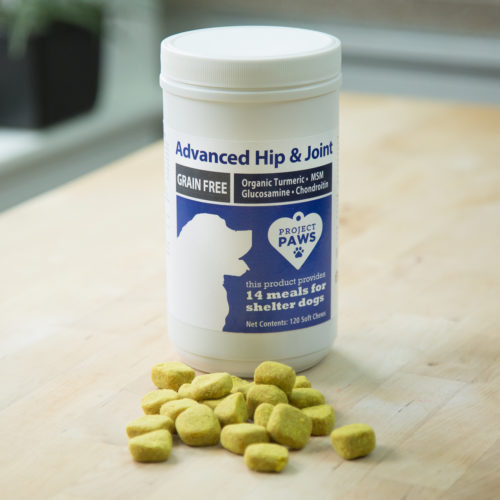
Has your dog slowed down as he’s gotten older? It’s a sad fact of life that many of our pets develop arthritis or other joint problems as they age.

According to The Dog Daily, “Scientific studies indicate that 20 percent of middle-aged dogs and 90 percent of older dogs have osteoarthritis in at least one joint.” Arthritis isn’t the only cause of joint pain in dogs. According to Pet Place:
“Currently, the risk of developing hip dysplasia in German Shepherds is 19 percent, in Labrador Retrievers 13 percent, in Golden Retrievers 21 percent and in Rottweilers 21 percent. Of the common large breed dogs, the St. Bernard (47 percent), Bloodhound (26 percent), Bullmastiff (25 percent), Newfoundland (22 percent) and Chesapeake Bay Retriever (22 percent) have the highest incidence of hip dysplasia. Of the smaller dogs, the Pug (60 percent) and Bulldog (73 percent) have the highest incidence.”
There are other causes of joint pain in senior dogs as well. According to Preventive Vet, “Other causes can also include degeneration of the nerves, muscle weakness and/or muscle mass loss, or even a torn cruciate ligament.”
With all of that, it’s no wonder that so many of our aging fur children deal with some level of joint pain. So what can you do to help your senior dog deal with joint pain? Luckily, there are plenty of things you can try in order to improve your dog’s quality of life. It usually works best if you include several of the following techniques rather than relying on just one.
Exercise
While you may think your dog would rather lay around all day rather than being active and burning calories, exercise actually helps senior dogs remain more mobile, even as they deal with joint pain. Obviously, you will need to reduce the intensity and length of walks or other exercises, but eliminating exercise entirely can actually cause your dog more pain and stiffness in the long run.

Maintaining a healthy weight
It should go without saying, but any unnecessary weight on your dog’s joints will only cause additional pain. If your dog is overweight, you should work with your vet to develop a diet and exercise program to help your dog reach a healthy weight. He’s likely to feel better once the extra load on his joints is gone.
Massage
If you have ever had a massage, you can appreciate how relaxed and healed you feel afterward. Luckily, we live in a time where canine massage therapy is becoming more prevalent. The National Board of Certification for Animal Acupressure & Massage (NBCAAM) has developed standardized national testing examinations and maintains a listing of certified Canine Massage Practitioners as well as Certified Acupressure Practitioners to help you find somebody trustworthy to help your dog feel better.

Acupuncture
While the idea of having many tiny needles inserted into you or your dog’s skin may sound painful, PetMD lists the following benefits of canine acupuncture:
-
Veterinary acupuncture stimulates the release of the body’s own pain-relieving and anti-inflammatory substances.
-
Relaxation of muscles at the site of needle insertion and more distant locations [in the] body is achieved with veterinary acupuncture treatment, creating both a local and generalized pain-relieving effect.
-
Veterinary acupuncture improves tissue blood flow, oxygenation, and removal of metabolic wastes and toxins.
-
Unlike prescription and over the counter pain medications, veterinary acupuncture lacks potential adverse side effects for your pet’s internal organs.
-
Your pet’s medications or supplements will not adversely interact with veterinary acupuncture treatment; therefore it can safely be used to treat a variety of illnesses.
The American Academy of Veterinary Acupuncture (AAVA) offers a list of certified veterinary acupuncture providers.

Laser
Laser therapy is a newer advancement in the field of veterinary science. According to The Bark, “Class IV therapeutic laser is a newer form of treatment that stimulates blood flow to tissues and can greatly improve arthritic conditions.”
Trimmed nails
Overly long nails can alter your dog’s foot structure and gait, causing unnecessary additional pain. If your dog hates having his nails trimmed, it is worth it to take him to the vet or groomer for regular nail trims. There is a vein in the nail (called the quick) that causes pain and bleeding if it is cut too short, but cutting right up to the edge of that vein as often as once a week will help the vein recede, and, in time, your dog’s quicks will actually recede to a length that helps relieve the pain associated with overly long nails.

Tools
There are countless tools you can use in and around your home to help maintain your dog’s comfort level and reduce strain on his sore joints. Here is just a sample of tools that can improve your dog’s quality of life:
-Nonslip flooring (such as rugs on hardwood floors)
–Ramps or stairs for getting into cars or onto furniture
-Warm bedding, a warm room, hot (but not too hot) compresses
–Floor-gripping booties or nail covers for better traction
-A harness for helping them stand without destroying your back
-A wheelchair for dogs with excessive rear end pain that have an otherwise good quality of life
-Keeping food and water bowls near their favorite bed(s) so that they don’t risk dehydration due to the pain they may experience trying to get to a water bowl

Medication
There are a wide variety of medications on the market that can help ease your dog’s pain, from anti-inflammatories to pain relievers. Each medication carries its own risk of side effects, so medication is something you will want to discuss carefully with your vet.
Supplements
Fish oil (or, better yet, krill oil) contains plenty of omega-3, which has been shown to have a wide variety of health benefits. According to the AKC:
“There are three types of dietary fats: saturated fats, monounsaturated fats, and polyunsaturated fats (PUFA). Omega fatty acids are found in PUFA, and they manufacture important hormones that are not naturally found in the body. Your dog needs polyunsaturated fats (PUFA), omega-3 and omega-6, in his diet for a variety of reasons:
-
The hormones in omega-6 increase inflammation and the immune response, blood clotting, and cell growth
-
Omega-3 balances the properties of omega-6 and acts as an anti-inflammatory in conditions like allergies, arthritis, and other inflammatory diseases
-
Omega-3 also improves skin and coat health, joint health, and energy
-
Omega-3 aids in cognitive development in puppies and may improve cognitive function in older dogs”

You may have been recommended glucosamine and chondroitin if you suffer from joint pain yourself, and these same supplements are recommended for dogs as well. According to PetMD:
“Supplements to the dog’s diet – such as glucosamine, chondroitin sulfate, omega-3 fatty acids, vitamin E, selenium, and MSM (methylsulfonylmethane) – can assist in decreasing inflammation and improving the body’s ability to repair and strengthen joint tissues. And while high-quality supplements are very safe, they tend to work best in combination with other forms of arthritis treatment.”
We recommend our trusted Project Paws® line of high-quality joint care supplements, which have the bonus of giving back meals to shelter dogs in need per product!
So you see, there are a wide variety of things you can try in order to help ease your dog’s joint pain. The more of these things you try, the better chance you have of increasing your dog’s quality of life, thus increasing the number of happy years you can spend with him.
These statements have not been evaluated by the Food and Drug Administration. This product is not intended to diagnose, treat, cure, or prevent any disease. The information on this website is not intended to replace a one-on-one relationship with a qualified healthcare professional.
(H/T: The Bark, VetStreet, Preventive Vet)
via Whisker Therapy


